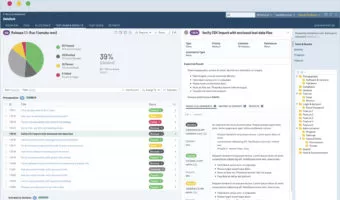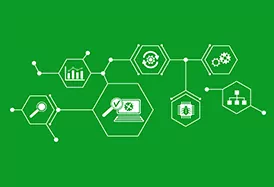![]() Arguably the most important aspect of product development, quality assurance and testing services help guarantee products are secure, adaptable and responsive across any number of scenarios. Software glitches or hardware problems that negatively impact the user experience can result in reputational damage. Implementing QA testing services throughout the product development life cycle can deliver numerous benefits.
Arguably the most important aspect of product development, quality assurance and testing services help guarantee products are secure, adaptable and responsive across any number of scenarios. Software glitches or hardware problems that negatively impact the user experience can result in reputational damage. Implementing QA testing services throughout the product development life cycle can deliver numerous benefits.
From the rise of AI and chatbots to big data analytics to IoT devices built to improve business and the world in general, hardware and software products will continue to play an increasingly vital role in our daily lives, underscoring the critical importance of hardware testing and software quality assurance testing.
Why Quality Assurance Is Critical to Product Development
What is quality assurance? Quality assurance, aka QA, ensures the creation of the highest-quality product — digital or physical — that works as well as possible as often as possible. Since companies across industries are judged by the excellence of the products they deliver, regression testing and other QA testing services are essential to assuring product quality. Any product — regardless of how well it was designed — is not going to perform well in the market without correct and consistent functionality. Consequently, QA testing encompasses all activities and services aimed at making sure your software or mobile application is running properly without any problems, and that every hardware component is operating as it should, and that the system is performing in exact accordance with the specific local requirements and industry standards before it is released to the public. Quality assurance not only ensures products meet user experience (UX) standards but that developers gain insight into how the product development process can be improved. From a product’s ideation all the way through to launch, quality should remain a priority at every step of the design and development process.
At Cardinal Peak, we understand that QA is not just a one-time occurrence. Testing early and often allows issues to be found and fixed and potential improvements to be implemented as soon as possible. That’s why quality assurance testing is engineered into our product design and development process from day one. Whether providing QA testing services as a standalone offering or as part of an end-to-end project, our robust QA team collaborates closely with developers, managers and product owners — on your team or ours — to reduce the uncertainty involved in launching the innovations of tomorrow.
Visit our Zigbee, Matter, Thread & Bluetooth Mesh IoT Testing Services page to learn more about IoT device testing at scale.
QA Testing Related Articles
Are you looking for more comprehensive information about software quality assurance, IoT testing or Cardinal Peak’s quality assurance testing services? The following blog posts provide additional details.

Q&A With QA — Why Cardinal Peak Implements QA at Every Step: Part I
In this question-and-answer style blog post, our quality assurance team delves into the importance of QA and why we engineer quality testing into each step of the engineering process.

Why We Use TestRail for Software Testing
Software testing in the real world can be challenging. Summarizing a webinar he presented, in this post our director of QA engineering discusses why we utilize TestRail for our test case management.

The Power of QA Testing Tools in Product Development
Gain insights into the power of QA testing tools in this informative post. Discover how our rigorous testing methodologies and diverse knowledge helps deliver state-of-the-art innovations.
In this question-and-answer style blog post, our quality assurance team delves into the importance of QA and why we engineer quality testing into each step of the engineering process.
Software testing in the real world can be challenging. Summarizing a webinar he presented, in this post our director of QA engineering discusses why we utilize TestRail for our test case management.
Gain insights into the power of QA testing tools in this informative post. Discover how our rigorous testing methodologies and diverse knowledge helps deliver state-of-the-art innovations.
The Value of Quality Assurance Testing
Quality assurance testing helps guarantee products work efficiently across multiple scenarios. When QA testing services are implemented throughout the product development life cycle numerous benefits can result.
- Lower the risk associated with product development.
- Improve product quality and security.
- Save development costs and increase profit.
- Deliver a better user experience.
- Enhance confidence in the product.
- Free your internal dev team to do what they do best: design products that delight your customers.
Read more about specific IoT device testing challenges and considerations.
The Cardinal Peak Quality Assurance Process
As a leading QA testing company, we have extensive test capabilities that can be utilized to support your needs. Refined through hundreds of projects, our QA process is engineered into each stage of development so that we empower clients to successfully launch fully tested, market-ready products.

Starting with features, use-cases and requirements, the QA team develops test plans and procedures. During development sprints, QA tests new features as they are developed and performs regression tests to make sure everything works together. Where appropriate, QA engineers automate tests that will be repeated. This is followed by user testing. Our team manages alpha and beta testing, as well as coordinating user acceptance testing (UAT) for product release. The team combines field-reported errors and removes duplicates. Any defects that QA identifies are assigned to developers. For ongoing support, QA tests updates and security patches. If you’re interested in a career in QA, check out our page on what it’s like to be a Software Development Engineer in Test (SDET) at Cardinal Peak.
No one step is more important than any others, but having solid and clear requirements is critical because those serve as the foundation for testing, and the more defined they are, the more accurate the tests can be. The success of any QA testing endeavor — whether app testing, IoT testing, hardware testing or testing software quality — ultimately depends on every step of our process because missing just one could lead to a problem in the real world. That’s why our QA process flow follows generally the same path regardless of the product.
Quality Assurance Testing Tools
At Cardinal Peak, our general QA process remains the same no matter the product being developed. However, we do leverage different tools to create test cases and test products in development.
Voice Testing Lab
Our dedicated voice testing lab supports development, tuning and Alexa Voice Services (AVS) self-tests.
Physical Testing
Physical testing assets include dozens of smartphones and tablets (iOS and Android); a Faraday enclosure for isolated radio frequency testing and Wi-Fi/Bluetooth drop-out testing; Bluetooth sniffers; and battery testing equipment.
Software QA
Software testing tools include TestRail for test case management; Pytest for testing, logging and reporting; Selenium and Appium for automated UI testing; and AWS Device Farm and Sauce Labs for remote access to device pools.
Compliance and Reliability
We utilize NCEE Labs facilities as part of our FCC, CE and UL testing procedures.
QA Testing FAQs
What Are the Types of Quality Assurance Testing?
When it comes to ensuring the quality of your product, there are several types of QA tests that a company should be aware of to be sure the product conforms to explicit or implicit requirements and expectations. Here are several of the most common different tests:
|
|
Should I Outsource QA?
Quality assurance testing is essential to avoid wasting valuable time, money and resources on developing a product that won’t be used or bought. While your company might have the in-house staff and resources necessary to perform QA testing, your revenue, profitability, efficiency or reputation is on the line, so unless you have extensive QA/QC experience, QA outsourcing might make more sense. Just remember to partner with a product design engineering company that prioritizes QA, possesses unique quality testing specialties and is committed to the quality of your product.
At Cardinal Peak, we provide outsourced QA testing services that can be utilized to support your internal testing and product development needs. From offloading your internal team and lowering your development risk to reducing project costs and improving product quality, the testing expertise we provide offers countless benefits.
What is the Difference Between QA and Testing?
Generally speaking, the difference between QA and testing is that quality assurance involves all of the processes and procedures — including testing — that help ensure the project conforms to the expectations of stakeholders, while testing is the process of exploring the product’s components to discover any defects.
Testing centers around finding existing bugs and aims to control the quality of the product, whereas QA focuses on avoiding mistakes to assure the product’s quality. To successfully launch fully tested, market-ready products, both QA and testing are essential. Testing is a small portion of a comprehensive QA strategy since you cannot assure the quality of any product that you don’t test.
